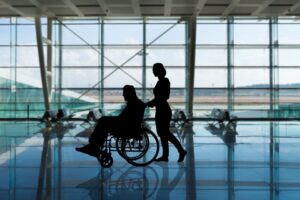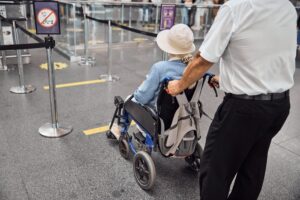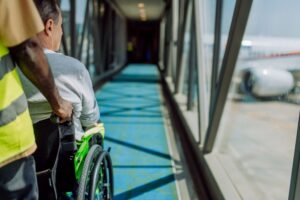This article is written in co-authorship with two power-wheelchair users and experienced travelers: Catherine Sokol, Wheel the World blog contributor, travel enthusiast, and budding disability advocate, and Valeria Rocha, one of Wheel the World’s talented software engineers.

Can I Take My Electric Wheelchair on a Plane?
Although air travel has improved accessibility for travelers with disabilities, it still remains particularly challenging for those who rely on power wheelchairs. Currently, unlike ground transportation, travelers in wheelchairs must transfer to airline seats while their power wheelchairs are stored in the cargo hold. This process can be problematic because most wheelchairs are customized for personal comfort and safety. Forced transfers can additionally pose injury risks.
Despite the challenges, flying with a power wheelchair is definitely possible and should not be viewed as off-limits. With adequate preparation and research, you can navigate air travel successfully. In this article, we’ll share essential tips to make your journey smoother.
Before Purchasing a Ticket
Research the Airline’s Power Wheelchair Policies
Unfortunately, there is little standardization on policies that apply to travelers who use a power wheelchair. It depends not only on your destination’s legal regulations but also on the airline’s policies.
Research the airline’s website and contact them before purchasing your ticket so you can know their particular policies and they can guide you to the best option. As an example, some airlines require you to discharge the battery of your wheelchair, and others require a doctor’s note about why you need the mobility device.
Find Airline Reviews from Other Power Wheelchair-Users
Find accessible travel blog posts, online groups, and other online communities to read about other powered wheelchair users’ experiences. This can help you evaluate which one is best for you. Wheel the World has an accessible travel Facebook group you can join and is a great place to start as a free resource. You can ask advice, get suggestions, and meet travelers. Everyone is welcome!

Pre-Flight Tips: How to Prepare Your Power Wheelchair
Know the Main Characteristics of your Equipment
First, knowing your electric wheelchair is key. The airport and airline staff might ask you about your wheelchair’s dimensions, the type of battery, how it should be handled, the weight, and the model. Prepare all the information beforehand on your phone (or written if you prefer) to help you answer correctly and confidently since you will probably be asked about this more than once.
Label Your Wheelchair
American Airlines recommends you label your powered wheelchair with your name, address, phone number, the wheelchair’s model, and serial number. This can help in case any airline loses your wheelchair and allows you and the airline staff to have that information available.
Write Down Instructions on How Your Wheelchair Should be Handled
Attach a laminated instruction sheet with information on how you would like your wheelchair to be handled. Consider adding info on how to assemble or disassemble crucial components. Providing these instructions to the airline staff can help them load and unload easier to prevent damage, ensuring it arrives at your destination in good condition.
Research Battery Policies
Depending on the airline and type of battery, policies may vary. This is why it’s so important for you to thoroughly research the airline before booking a flight. Some airlines require you to uncharge it, others to remove it. For example, lithium-ion batteries are typically required to be removed, protected, and stored in your carry-on luggage. Some battery types are not required to be removed, so knowing the exact airline requirements allows you to prepare yourself.

Protect Areas Where Breakage is Highly Likely
Such as the joystick! Also, fold pieces in to make it as compact as possible. Remove any of the parts that can come off the chair and bring them with you into the cabin. These parts include the footrest, headrest, and joystick. Covering the chair with a waterproof cover can help protect it from water damage when being loaded into the plane.
Bring an Able Sling for Transfers
If you need, purchase or bring an able sling. Airlines typically use an aisle chair to go down the narrow plane, so bringing an able sling can help make the transfer process much safer.
When You Get to the Airport
Take a Picture of Your Wheelchair Before the Flight
Taking a picture of your wheelchair and it’s current condition when you get to the airport will help in case damage occurs during the flight. Airlines are ultimately responsible for any damage, so having a picture pre-flight is proof that the airline caused the damage.
Don’t Forget Your Wheelchair Cushion
If you prefer, don’t forget to grab your wheelchair cushion before boarding the plane. This will allow for a more comfortable seat, especially if it is a longer flight. You could also pack a separate cushion to bring on the plane.
Be Patient!
As we said, air travel has a long way ahead to be fully accessible. In the meantime, powered wheelchair users have to be patient. You’ll most likely be asked about your disability and mobility device when purchasing a ticket, checking in, going through security, and boarding the plane. Often, the staff involved in all these steps do not communicate with each other, which means you will most likely repeat yourself. The only tip we have for this is patience.

Know the Air Carrier Access Act and Advocate for Yourself
You know what you need best! So don’t be afraid to speak up and tell airline workers what you need. They don’t know how to best help you, so it is up to you to tell them. Be kind but be firm; they are there to help you. Ultimately, their goal is for you to have the best flight possible and you’re perfectly within your rights to ask for help and speak up for what you need.
To help with this, know the Air Carrier Access Act (ACAA), which prohibits discrimination on the basis of disability in air travel. According to the Department of Transportation, “this rule applies to all flights of U.S. airlines, and to flights to or from the United States by foreign airlines.” Print out a copy or have it ready on your phone so you can address it if necessary. This act protects individuals with disabilities, so don’t be afraid to speak up. Read more about the Amputee Coalition’s endorsement of this act.
Share Your Own Tips!
It seems daunting, but flying can be a wonderful experience and a great way to see different parts of the world. Hopefully, one day, wheelchair users will be allowed to stay in their chairs on the flight, but until then, we will do what we need to do, and with a little planning, flying can be a wonderful way to travel.
We can help each other out by sharing tips and tricks that have worked for you! If you have something to share that would benefit others in the limb loss or limb difference community, please join the Amputee Coalition’s Advocacy community on AC Connect!
Blog originally published by Wheel the World and edited by Amputee Coalition.
In partnership with Wheel the World, the Amputee Coalition will receive a donation with every travel booking made using the code ‘AMPUTEECOALITION.’

